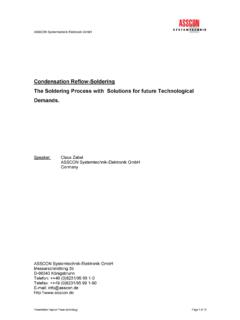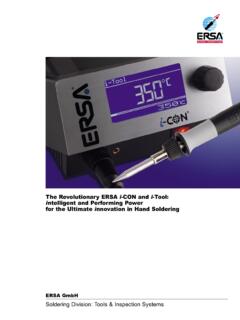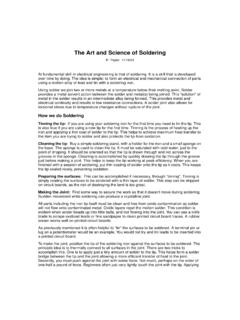Transcription of Wave Soldering is in no way a dying art! - kurtzersa.com
1 "Wave Soldering is in no way a dying art!" Technical article published by "Markt & Technik", issue 6, 02_2012 Ersa GmbH GmbH und Markt & Technik page 1 / 6 Karin Z hlke, Markt & Technik J rgen Friedrich, Ersa GmbH Commonly held preconceptions about wave Soldering are mostly the result of its highly complex process controls Wave Soldering is in no way a dying art! Ersa, with its newly introduced nitrogen-inerted wave Soldering system POWERFLOW e N2 , goes to bat for the wave Soldering technology! At the same time, Ersa is removing a number of commonly held preconceptions against this Soldering process. With the development of SMT components about 30 years ago, most experts predicted that the use of leaded THT components would rapidly decline.
2 Yet, despite this prediction, THT components still play an important role in today s electronic manufacturing environment. J rgen Friedrich, manager of applications technology at Ersa, states that, despite all the prophecies of the imminent demise of wave Soldering , it should not be considered a dying art. While it is true that the wave Soldering process is not as easily controlled as that of Reflow Soldering a fact, adding to the negative image of wave Soldering - these perceived difficulties have led, over the years, to a number of preconceptions: One of the misconceptions, for example, states that the wave Soldering process whether with leaded or unleaded solder will always entail the possibility of bridging at critical locations.
3 Not even an excellent layout would be able to completely eliminate this danger. But how is this viewed by the designer of the system? The parameters which influence the occurrence of solder bridging are found in the layout and design of the assembly as well as by the process control made available by the system , explains Friedrich. In the design of an assembly, parameters controlled should be the orientation of the components, the size of the solder pads and their spacing, the length of the components leads as well as the metallization of the solderable surfaces. In the wave Soldering process, parameters which may cause bridging are: solder alloys, fluxes and the amount of flux dispensed, preheat temperatures, contact time in the wave and the "Wave Soldering is in no way a dying art!
4 " Technical article published by "Markt & Technik", issue 6, 02_2012 Ersa GmbH GmbH und Markt & Technik page 2 / 6 atmosphere in the solder module. From this list of parameters influencing the quality of the wave Soldering process, it can easily be seen that the interactions that can lead to bridging are of a complex nature, since each parameter in it can influence the quality. Friedrich outlines: If bridging cannot be eliminated, after having exhausted all the possibilities and the wave Soldering system is optimally set up, then, as a rule, the cause for the bridging lies in the design of the board . If components with very small contact spacing are being used, then it is most likely that the solder pads are placed too close together, so that the solder cannot adequately drain from the solder joint.
5 The attendant high wetting forces, solely due to the total surfaces areas of the pin and the pad, are preventing the separation. The surface tension of the solder in combination with the high wetting forces inevitably leads to the formation of solder bridges, since the weight force of the solder, which is the only downward-acting force, is not sufficient to pull the solder away from the solder joint. Whoever is the stronger, wins , and in this case the PCB is the stronger . Yet, the causes can also be of a more trivial nature: From time to time, incorrect solder programs may be loaded into the system. If an assembly is processed with incorrect Soldering parameters, so that, for example, insufficient flux is dispensed, or the preheat temperature is too low respectively the contact time over the wave is too short, solder bridges can be the result, even though the layout of the assembly is correct.
6 To sustainably eliminate the causes for bridging, comprehensive process knowledge is required. If an operator changes, in order to improve an unsatisfactory quality situation, process parameters in an uncoordinated and uninformed way, the quality of the product may deteriorate further. This is unavoidable, if the operator does not fully understand the correlations and the reciprocal effects these changes may have , notes Friedrich. Ersa s POWERFLOW e N2 stores all relevant Soldering parameters for each assembly in solder programs, starting with the board size, flux volume, preheat temperature profile, wave heights, and clearance height over the solder nozzles.
7 Also recorded are the individually adjustable conveyor speeds in the preheat as well as the Soldering sections. Friedrich knows of the reservations by the users when the subject turns to lead-free Soldering . But lead-free, more specifically RoHs conforming solder alloys and wave Soldering do not, as a rule, exclude each other. With lead-free alloys, quality standards known to be achievable with tin-lead solders can also be achieved . The commonly applied IPC A 610 can therefore be applied to lead-free solder joints as well. What drastically is changing, notes Friedrich, is the process window that is available in lead-free Soldering . The process window in the lead-free process is, when compared to that of tin/lead solders, frequently smaller.
8 As a result, lead-free processes need to consider in much closer detail the individual requirements "Wave Soldering is in no way a dying art!" Technical article published by "Markt & Technik", issue 6, 02_2012 Ersa GmbH GmbH und Markt & Technik page 3 / 6 of a specific assembly. As a general rule, it can be stated that with any increase in the need for thermal energy of an assembly, the demands on the process increase . Falling into the realm of thermal management, the possible lack of capillary rise on THT components is one quality attribute frequently encountered. In the wave Soldering process, the working temperatures of the tin/lead (approx.)
9 250 C) and lead-free (approx. 260 C) solders are on a similar level. The melting points of the solders though vary by up to 48 C from each other. This causes lead-free solder to solidify much quicker than tin-lead solder, since during the cool down cycle the solidification temperature is reached earlier. This means, that the thermal capacity of a solder joint greatly influences the ability of the solder to rise up through the plated-through hole. When processing components and/or assemblies with high thermal capacities, it is imperative that the board is designed such that the solder joint itself is thermally decoupled from the surrounding area.
10 The transfer of thermal energy from the solder joint to the surrounding assembly has to be reduced as much as possible , explains Friedrich. Needless to say the Soldering system itself has to be capable to supply the energy required. For these and other reasons, the demands on modern wave Soldering systems are very high, as is demonstrated by Ersa s POWERFLOW. Systems on the leading edge of technology store all relevant Soldering parameters, on a board level, in separate Soldering programs. Board size, flux volumes deposited, preheat profiles, wave heights, clearance height at the solder waves, conveyor speeds in the preheating and the Soldering section, all the parameters are recorded for future reference.









